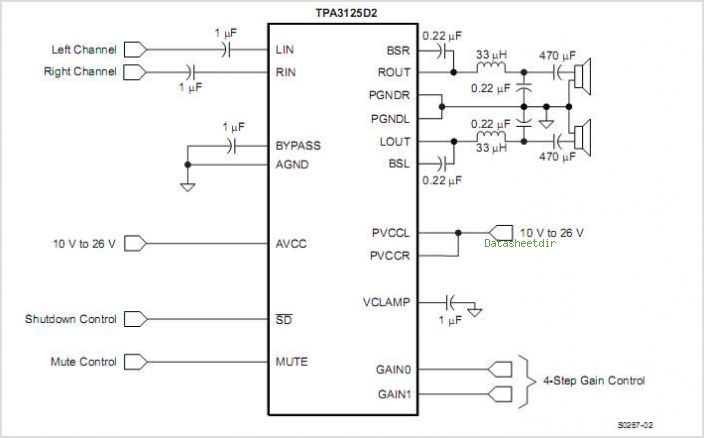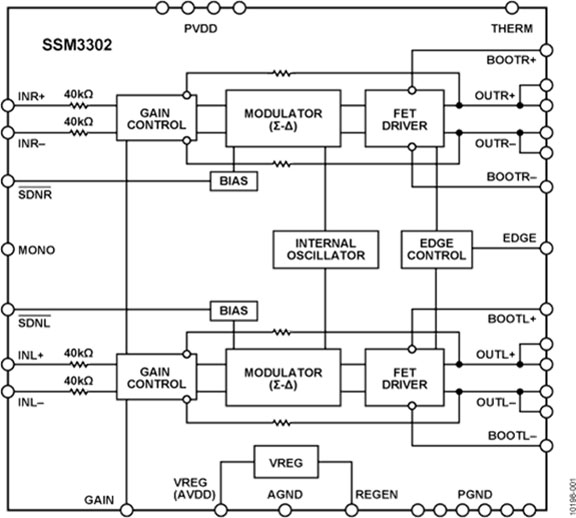BY JIM HARRISON, Sr. Technical Editor
If you need to drive some speakers with really good audio, you have some really good choices these days. Tripath, in San Jose, CA, was the first to introduce a Class-D amplifier chip, the TA1101, in 1996. It was used in Apple's Power Mac G4 Cube.
Class-A amps are pretty simple devices. Here, the amplifier’s output FETs must be conducting through the full 360-degree cycle of a waveform. They can have a very linear output, but take a lot of power.
Class-B uses a push/pull arrangement in such a way that only half the output devices are conducting at any given time: one half covers the +180 degree portion of the waveform, while the other covers the -180 degree section. Efficiency is improved but crossover distortion interferes with fidelity.
Class-D circuits are found in many audio applications — either in vehicles, where it achieves high output levels, or in personal audio devices, where its efficiency contributes to long battery life. Class-D can have up to 90% efficiency, much more efficient than Class-A (15-30%). In a Class-D amplifier, the output FETs are driven to produce an output square-wave at a frequency outside the range of human hearing. Instead of modulating the amplitude, the circuit uses pulse width modulation corresponding to amplitude. With the FETs operating in either cutoff or saturation, losses come primarily from the FETs forward-voltage drops. An L-C output filter returns the signal to audio. Often feedback is used after the filter to reduce detrimental effects of varying load impedance.
Some example Class-D amplifiers
The MAX98372 15 W amplifier from MaximIntegrated has a digital input and features dynamic headroom tracking (DHT) and brownout protection. DHT automatically optimizes the headroom available as the power supply voltage varies, perhaps due to transients or declining battery life, to maintain a consistent listening experience. The ICs digital audio interface (DAI) supports I2 S, left-justified, and TDM formats with 32 kHz, 44.1 kHz, 48 kHz, 88.2 kHz, and 96 kHz sample rates with 16-/24-/32-bit data supported for all data formats. Supply voltage can be 5.5 to 18V. Supply range allows the device to reach 19 W into an 8 Ω load.
The chip's digital audio interface (DAI) supports I2 S, left-justified, and TDM formats. It accepts 32 kHz, 44.1 kHz, 48 kHz, 88.2 kHz, and 96 kHz sample rates with 16-/24-/32-bit data for all formats. In TDM mode, the device can support up to 16 channels of audio data. A unique clocking structure eliminates the need for an external MCLK signal that is typically needed for PCM communication. The IC is available in a 0.4mm pitch, 2.2 x 2.8mm, 30-bump WLP package. At half power, THD+N is 0.02%. Price is around $1.14 ea/1,000.
Texas Instruments really gets into this segment, with many Class-D amplifiers, including analog or digital input types. For analog input, the TPA3125D2 is a stereo 10-W/channel device that uses a 10 to 26 V supply and comes in a 20-pin DIP package. The efficiency of the chip allows it to operate without a heat sink and its thru-hole package allows for a single sided PCB. Quiescent supply current is 30 ma, maximum, and THD+noise is 0.04% at 1 KHz and 5 W out. You can find it for $1.50 ea/240.

Fig. 1: The Texas Instruments TPA3125D2.
Rohm offers the BD5426EFS 10 + 10 W stereo Class-D power amplifier employing state-of-the-art Bipolar, CMOS, and DMOS process technologies. The analog input IC achieves efficiency of 87% (9W + 9W output with 8 Ω load). It has a 5 × 7.5 × 1.0 mm back-surface heat radiation power package that does not need a heat sink. PWM frequencies are adjustable from 250 to 400 kHz. Total THD is 0.1% at 1 W out. $3.40 ea/1,500.
The On Semiconductor LV49152V is a 15 W/channel stereo amp with analog inputs. Efficiency is 93%, and feedback technology achieves excellent audio quality. THD+N is 0.08% typical and 0.4% maximum at 1 KHz and 1 W output, and quiescent current is 45 ma typical. The IC comes in a SSOP44J (275mil) package. From $2.49 ea/1,000.

Fig 2: The Analog Devices SSM3302.
The Analog Devices 2 × 10 W filterless Class-D audio amplifier uses spread spectrum pulse density modulation for reduced radiated EMI. The chip's THD + N at 5 W into 8 Ω is 0.01% and supply voltage is 7 to 18 V. The IC operates with an efficiency of 90% at 7 W into 8 Ω. It is available in a halide-free 40 lead 6 × 6 mm lead frame chip scale package (LFCSP). It costs $2.92 ea/1,000.
The TDA8932B 2 x 15 W high efficiency Class-D amplifier from NXPSemiconductor features low power and does not require a heat sink. The chip includes thermal foldback and dual differential inputs. It takes a supply voltage of 10 V to 36 V asymmetrical or +-5 V to +-18 V symmetrical, and quiescent current is 40 ma typical. The output of the amplifier is a PWM signal with a carrier frequency of between 300 and 500 kHz. THD+N is 0.05% maximum at 1 kHz and 1 W output. You can obtain this device for just $1.35 ea/1,000. It come in a SO32 or HTTSOP32 package.
Advertisement
Learn more about Maxim IntegratedNXP SemiconductorsON SemiconductorROHM SemiconductorTexas Instruments





